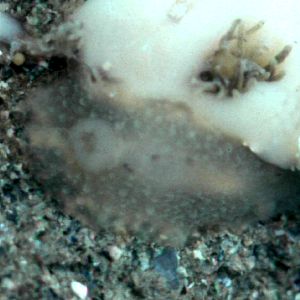

Hallaxa chani
Gosliner & Williams, 1975
Order: NUDIBRANCHIA
Suborder: DORIDINA
Superfamily: EUDORIDOIDEA
Family: Actinocyclidae
DISTRIBUTION
Hallaxa chani ranges from central California to southeast Alaska (Gosliner & Williams, 1975; Millen, 1989).
PHOTO
UPPER RIGHT: showiing three animals on the underside of of a cobble at North Cove, Cape Arago, Oregon, 31 August 1981 alongside a colony of their food sponge Halisarca.
LOWER RIGHT: The translucent, almost transparent, nature of the body can be seen. This enhances its ability to be perfectly camouflaged on its food sponge, as the background colour shows through.
Photos: J. Goddard.
Hallaxa chani ranges from central California to southeast Alaska and grows to about 30 mm in length. It is rare in the southern part of its range, but in the Pacific Northwest, can be quite common in boulder/cobble habitats with large populations of its sponge prey, Halisarca sp. (Goddard, 1981, 1984; Goddard et al., 1997). Most records of Hallaxa chani are from the intertidal zone, but Millen (1983 and 1989) found it subtidally at unspecified depths in British Columbia and Alaska.
Hallaxa chani preys exclusively on Halisarca sp., a slick-textured dendroceratid sponge lacking both spicules and spongin fibers (Goddard, 1981, 1984, 1998). Like its congeners, Hallaxa chani is remarkably cryptic on its prey, both in color and texture. Both are tan to yellow-tan in color, and Hallaxa chani also lacks spicules. Additionally, the mantle edge of Hallaxa chani is semi-translucent and blends in almost seamlessly when spread out on the surface of Halisarca sp.
The radular teeth of Hallaxa chani are similar in shape to those of other nudibranchs known to prey primarily on sponges that lack spicules and provided an early clue that Hallaxa chani does not feed on colonial ascidians as originally reported by McDonald & Nybakken (1978) (Goddard, 1981). As noted by Nybakken & McDonald (1981), nudibranchs that specialize on ascidians or fleshy ctenostome bryozoans have a radula dominated by large, paired, wing-shaped lateral teeth. Dorids specializing on dendroceratid and dictyoceratid sponges have thin, comb-like outer lateral teeth with multiple denticles (Goddard, 1981, personal observations; Rudman, 1984; and see electron micrographs of radulae in Gosliner & Johnson, 1994).
Cadlina modesta (which has outer lateral teeth similar in shape to Hallaxa chani) also feeds on Halisarca sp. (Goddard, 1984, 1998) and is a potential competitor of Hallaxa chani. However at Cape Arago, Oregon, twice as many C. modesta were found feeding on the pink-colored dendroceratid sponge Aplysilla glacialis, as on Halisarca sp. Moreover, in a laboratory preference test, three individuals of C. modesta chose Aplysilla glacialis over Halisarca sp. in 12 out of 12 trials (Goddard, unpublished data).
Hallaxa chani lays cream-colored, ribbon-shaped egg masses in a loose coil of 1.5 - 2 turns. At 11 to 15 degrees Celsius, typical planktotrophic veligers with coiled shells averaging 152 microns long hatch from these egg masses after an embryonic period of 15 - 17 days (Goddard, 1984).
References:
•Goddard, J. H. R. (1981) Range extension and notes on the food, morphology, and color pattern of the dorid nudibranch Hallaxa chani. The Veliger, 24(2): 155-158.
• Goddard, J. H. R. (1984) The opisthobranchs of Cape Arago, Oregon, with notes on their biology and a summary of benthic opisthobranchs known from Oregon. The Veliger, 27(2): 143-163.
• Goddard, J. H. R., T. A. Wayne & K. R. Wayne (1997) Opisthobranch mollusks and the pulmonate limpet Trimusculus reticulatus (Sowerby, 1835) from the outer Washington coast. The Veliger, 40(4): 292-297.
• Goddard, J. H.R. (1998) A summary of the prey of nudibranch molluscs from Cape Arago, Oregon. Opisthobranch Newsletter, 24(2): 11-14.
• Gosliner, T. M. & G. C. Williams (1975) A genus of dorid nudibranch previously unrecorded from the Pacific coast of the Americas, with the description of a new species. The Veliger, 17(4): 396-405.
• Gosliner, T. M. & S. Johnson (1994) Review of the genus Hallaxa (Nudibranchia: Actinocyclidae) with descriptions of nine new species. The Veliger, 37(2): 155-191.
• McDonald, G. R. & J. W. Nybakken (1978) Additional notes on the food of some California nudibranchs with a summary of known food habits of California species. The Veliger, 21(1): 110-119.
• Millen, S. V. (1983) Range extensions of opisthobranchs in the northeastern Pacific Ocean. The Veliger, 25(4): 383-386.
• Millen, S. V. (1989) Opisthobranch range extensions in Alaska with the first records of Cuthona viridis (Forbes, 1840) from the Pacific. The Veliger, 32(1): 64-68.
• Nybakken, J. W. & G. R. McDonald (1981) Feeding mechanisms of west American nudibranchs feeding on Bryozoa, Cnidaria and Ascidiacea, with special respect to the radula. Malacologia, 20(2): 439-449.
• Rudman, W. B. (1984) The chromodorididae (Opisthobranchia: Mollusca) of the Indo-West Pacific: a review of the genera. Zoological Journal of the Linnean Society, 81(2-3): 115-273.
Goddard, J., 2001 (September 5) Hallaxa chani Gosliner & Williams, 1975. [In] Sea Slug Forum. Australian Museum, Sydney. Available from http://www.seaslugforum.net/factsheet/hallchan
Related messages
-
Hallaxa chani from British Columbia
From: Paul Sim, November 12, 2007 -
Hallaxa chani from California
From: Bruce Wight, July 31, 2004 -
Re: Hallaxa chani from California
From: Jeff Goddard , July 31, 2004 -
Hallaxa chani from the northeastern Pacific
From: Jeff Goddard, September 9, 2001
